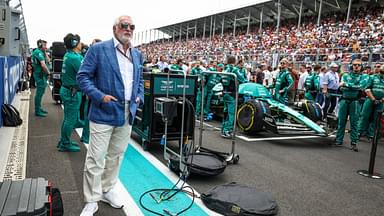The Safety Car in F1 is one of the critical ways in which the FIA manage various situations that take place on a race track. Most of the time, the FIA introduces a safety car period when there is an accident on the race track. However, the motorsport governing body at times also introduces a safety car when there is debris on the race track or when there is inclement weather (often poor visibility or excessive water on the circuit).
Since F1 cars are some of the fastest vehicles that exist in the world, fans often wonder how quickly the Safety Car moves and whether it can match the speed that the racing drivers are able to deliver on the track. While the safety car may not be as quick as F1 cars, it is yet incredibly fast.
And that is the case for both the Safety Cars — the Mercedes-AMG GT Black Series and the Aston Martin Vantage — that F1 uses in 2024. The Mercedes-AMG GT Black Series has a top speed of 202 mph, while the Aston Martin Vantage has a top speed of 195 mph.
In comparison, F1 cars can travel as fast as 233 mph. Although both safety cars have a decent top speed, fans will interestingly yet see drivers often complain on the radio about the pace at which the safety car is moving.
However, in the heat of racing, they often forget the purpose of a safety car is to manage the pace of the race, so that the marshals have enough time to clear out the debris. The 2024 season has witnessed more than 10 safety car periods, with the most recent coming at the Mexico City Grand Prix.
The Safety Car periods in the 2024 F1 season
F1 had their first safety car period of the 2024 season at the Saudi Arabian Grand Prix when Lance Stroll crashed into the barriers. The very next race in Australia featured two Virtual Safety Car (VSC) periods but never the full Safety Car.
The fourth race of the season in Japan featured the second time when there was a full safety car period. The safety car came out after Daniel Ricciardo and Alex Albon collided on the opening lap of the race.
In the very next race in China, there was a VSC period that was followed by the full safety car period. Initially, the FIA thought that the marshals could clear out Valtteri Bottas’ Sauber (suffered an engine failure) under a VSC. However, with that not possible, they introduced the full safety car period.
Most of the next few races after China featured either a full safety car period or a VSC. It was only after the Austrian GP in June that there was a huge gap in races when neither a Safety Car nor a VSC period featured.
While a VSC period featured during the Azerbaijan Grand Prix in September, a full safety car period was only introduced at the United States GP in October. The Safety Car came out in Austin after Lewis Hamilton uncharacteristically spun onto the gravel.
IT’S LIGHTS OUT, AND AWAY WE GO!
Max takes the lead in a frantic first lap that ends with a safety car pic.twitter.com/gSrtKYa9lE
— Sky Sports F1 (@SkySportsF1) October 27, 2024
In the Mexico City GP, Yuki Tsunoda and Alex Albon’s collision on lap 1 of the race brought out the safety car. Most safety car periods do indeed take place on the opening lap of a race as that is when there is the highest chance of collisions and crashes, with multiple drivers running close to each other, trying to get a good start and overtake as many cars as possible heading into the first corner.




